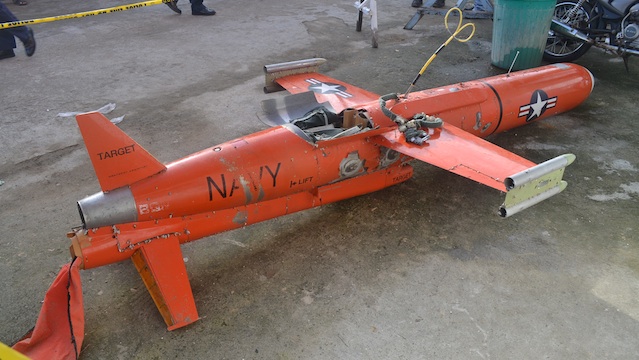SUMMARY
This is AI generated summarization, which may have errors. For context, always refer to the full article.

MANILA, Philippines – The US drone found off Masbate on Sunday was not armed or used for surveillance and was not even considered missing when it washed up in the Philippines, the US Navy said on Wednesday, January 9.
“[The drone] is not dangerous and was not armed,” stressed Cmdr. Ron Steiner, a spokesman for the U.S. Navy’s 7th Fleet.
Steiner told Rappler that they did not inform the Philippine authorities about the lost device because “it was not considered missing.”
Unmanned aerial vehicles (UAVs) like the one found off Masbate “are not always recovered, but the Navy makes every effort to retrieve [these drones] when possible,” the Navy officer explained.
Steiner was not able to confirm if the US Navy has asked for the Philippine military to return the drone.
The US Embassy in Manila said on Tuesday that the UAV was launched on Sept 19, 2012 from Guam during exercise Valiant Shield, a drill in which drones like this are used as targets for fighter jets.
No national sovereignty issue – DFA
The drone is now in the custody of the Philippine Navy at the Naval Forces Southern Luzon headquarters in Legaspi, where the device was transported after being checked by a bomb squad in Masbate.
Several partylist groups called on Tuesday for a Senate probe into the incident and accused the United States of violating Philippine territorial sovereignty under the Visiting Forces Agreement (VFA).
However, neither the government nor the Department of Foreign Affairs (DFA) has questioned the official explanation for the incident submitted by the US Embassy.
Asked about the issue during a DFA-sponsored lunch, Foreign Secretary Albert del Rosario clarified he did not accept the US statement “at face value” while local authorities are still investigating the incident.
Del Rosario however reminded the public that the device only washed up on national territory after almost four months and did not penetrate Philippine airspace.
“If it did not fly over Philippine territory, I don’t think that in that specific case there should be any specific sovereignty issues,” he said.

‘Long adrift’ at sea
The drone — a model BQM-74E Chukar III manufactured by US-based Northrup Grumman Corporation— is 3.93 m long and 71 cm high with a wingspan of 1.75 m, and is normally used in reconaissance missions by the US military although it is technically capable of delivering payloads and conducting surveillance operations.
Naval Forces Southern Luzon spokesman Capt. Rommel Galang said on Tuesday that the presence of barnacle growth on fuselage of the orange-colored device suggested it had been been “long adrift” at sea before reaching the Philippines.
Galang added that the drone “was assessed to be safe for transport but not recommended for dismantling due to lack of technical expertise to do this,” and clarified that it had the initials “USA” — not “USAID” as previously reported — painted on it.
The US has been training the Philippine military to use these drones against Muslim rebels in Mindanao, according to various US and Philippine officials.
President Benigno Aquino III confirmed last year that the Philippines has been allowing US drones to overfly its territory for reconnaissance flights, but were not allowed to make strikes.
Rappler reported in March that US smart bombs delivered by a different model Scan Eagle UAV were used for the first time on Philippine territory in a February 2 attack on Abu Sayyaf and Jemaah Islamiyah terrorists.
The raid was the result of 15 months of training and technology transfer from the United States to Filipino forces under a new aid program for counterterrorism efforts approved in 2010. – Rappler.com
Add a comment
How does this make you feel?
There are no comments yet. Add your comment to start the conversation.